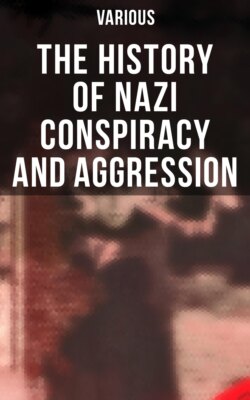Читать книгу The History of Nazi Conspiracy and Aggression - Various - Страница 104
На сайте Литреса книга снята с продажи.
EXPERIMENTS IN AGGRESSION
ОглавлениеBefore resorting to open aggressive warfare, the Nazis undertook some rather cautious experiments to test the spirit and resistance of those who lay across their path. They advanced, but only as others yielded, and kept in a position to draw back if they found a temper that made persistence dangerous.
On 7 March 1936, the Nazis reoccupied the Rhineland and then proceeded to fortify it in violation of the Treaty of Versailles and the Pact of Locarno. They encountered no substantial resistance and were emboldened to take the next step, which was the acquisition of Austria. Despite repeated assurances that Germany had no designs on Austria, invasion was perfected. Threat of attack forced Schuschnigg to resign as Chancellor of Austria and put the Nazi defendant Seyss-Inquart in his place. The latter immediately opened the frontier and invited Hitler to invade Austria “to preserve order.” On March 12th the invasion began. The next day, Hitler proclaimed himself Chief of the Austrian State, took command of its armed forces, and a law was enacted annexing Austria to Germany.
Threats of aggression had succeeded without arousing resistance. Fears nevertheless had been stirred. They were lulled by an assurance to the Czechoslovak Government that there would be no attack on that country. We will show that the Nazi Government already had detailed plans for the attack. We will lay before you the documents in which these conspirators planned to create an incident to justify their attack. They even gave consideration to assassinating their own Ambassador at Prague in order to create a sufficiently dramatic incident. They did precipitate a diplomatic crisis which endured through the summer. Hitler set September 30th as the day when troops should be ready for action. Under the threat of immediate war, the United Kingdom and France concluded a pact with Germany and Italy at Munich on September 29, 1938 which required Czechoslovakia to acquiesce in the cession of the Sudetenland to Germany. It was consummated by German occupation on October 1, 1938.
The Munich Pact pledged no further aggression against Czechoslovakia, but the Nazi pledge was lightly given and quickly broken. On the 15th of March, 1939, in defiance of the treaty of Munich itself, the Nazis seized and occupied Bohemia and Moravia, which constituted the major part of Czechoslovakia not already ceded to Germany. Once again the West stood aghast, but it dreaded war, it saw no remedy except war, and it hoped against hope that the Nazi fever for expansion had run its course. But the Nazi world was intoxicated by these unresisted successes in open alliance with Mussolini and covert alliance with Franco. Then, having made a deceitful, delaying peace with Russia, the conspirators entered upon the final phase of the plan to renew war.
